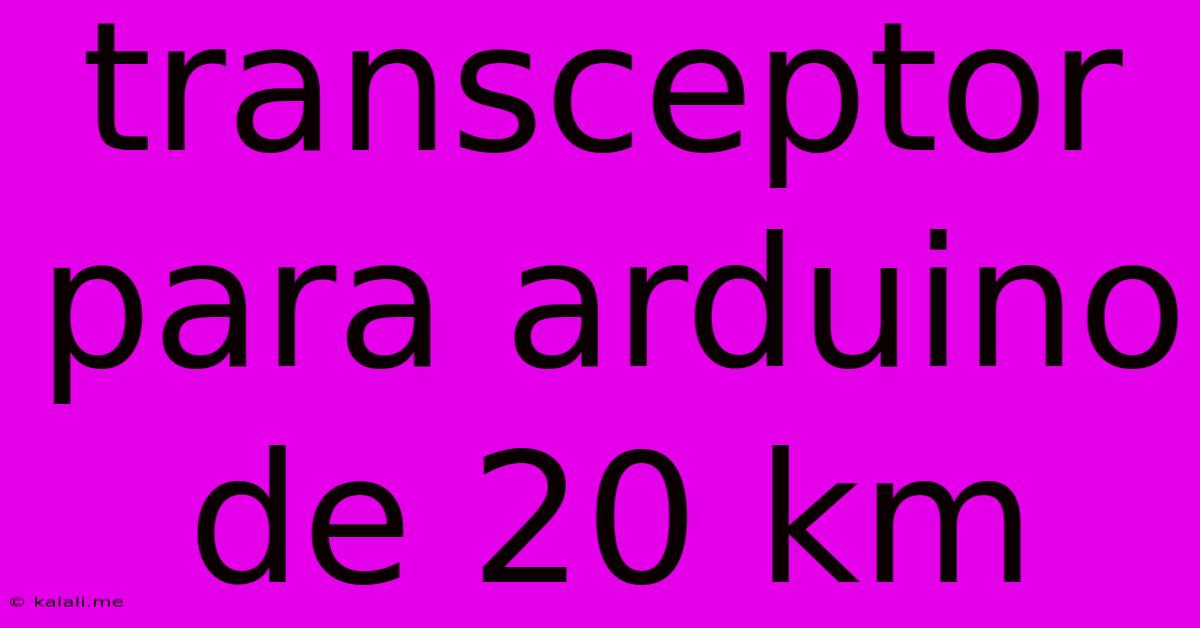Transceptor Para Arduino De 20 Km
Kalali
May 25, 2025 · 3 min read

Table of Contents
Achieving 20km Wireless Transmission with Arduino: A Deep Dive into Transceivers
This article explores the challenges and solutions involved in establishing a reliable 20km wireless communication link using Arduino. Achieving this range requires a significant understanding of radio frequency (RF) communication, antenna design, and power considerations. It's not a simple plug-and-play solution, but with careful planning and the right equipment, long-range communication is achievable.
Understanding the Limitations of Standard Arduino RF Modules:
Standard Arduino RF modules, often operating in the 433MHz or 915MHz range, are typically limited to a few hundred meters. The 20km range necessitates a different approach, demanding higher power output, more sensitive receivers, and directional antennas. Signal attenuation (weakening) over long distances is a major obstacle.
Key Components for Long-Range Arduino Communication:
- High-Power RF Transceiver: This is the cornerstone of a long-range system. You'll need a transceiver capable of significantly higher transmit power than typical low-power modules. Look for specifications mentioning output power (in dBm) and sensitivity (in dBm). Higher power and better sensitivity improve the chances of success.
- Directional Antennas: Omnidirectional antennas radiate signals in all directions, leading to signal loss. Directional antennas focus the signal in a specific direction, significantly boosting the effective range. Yagi antennas, parabolic dishes, or helical antennas are common choices for long-range applications. Antenna gain (in dBi) is crucial; higher gain means a more focused and powerful signal.
- Appropriate Frequency Band: The chosen frequency band plays a critical role. Regulations vary by region, and some frequencies are better suited for long-range communication than others. Research the legal frequencies available in your area. Factors like atmospheric absorption and potential interference need consideration.
- Amplifiers (Optional but Recommended): For truly long distances, amplifiers may be needed to boost both the transmit and receive signals. Careful matching of impedance is essential to avoid signal loss.
- Filtering: Filtering out noise and interference is crucial for reliable reception. Bandpass filters can help isolate the desired frequency band from unwanted signals.
Challenges and Considerations:
- Regulatory Compliance: Ensure your setup complies with all relevant radio frequency regulations in your location. Unauthorized transmissions can lead to legal consequences.
- Line-of-Sight: While not strictly required for all frequencies, line-of-sight significantly improves the reliability of long-range communication. Obstacles like buildings and hills can severely attenuate the signal.
- Multipath Propagation: Signals can bounce off various surfaces, leading to signal distortion and interference. This necessitates careful antenna placement and potentially more advanced signal processing techniques.
- Power Consumption: High-power transceivers consume significant energy. Power management strategies, such as low-power modes and efficient power supplies, are crucial for extended operation.
Software and Programming:
The Arduino IDE can handle the communication logic, but you may need custom libraries for specific transceiver modules. The software should manage data packets, error correction, and potentially more sophisticated modulation schemes (like MSK or GMSK) for improved reliability in noisy environments. Careful consideration needs to be given to error detection and correction mechanisms.
Conclusion:
Creating a 20km wireless link with Arduino is a complex undertaking, demanding specialized hardware and a deep understanding of RF communication principles. Careful planning, selection of appropriate components, and attention to regulatory compliance are essential for success. While challenging, the rewards of achieving long-range wireless communication with Arduino can be significant for various applications. Remember to prioritize safety and legal compliance throughout the design and implementation process.
Latest Posts
Latest Posts
-
How To Work Out Voltage Drop
May 25, 2025
-
Weight Of 1 Liter Of Water
May 25, 2025
-
What To Use Instead Of Parchment Paper
May 25, 2025
-
How Do You Get An Umbreon On Pokemon Go
May 25, 2025
-
How To Stop Sneakers From Squeaking
May 25, 2025
Related Post
Thank you for visiting our website which covers about Transceptor Para Arduino De 20 Km . We hope the information provided has been useful to you. Feel free to contact us if you have any questions or need further assistance. See you next time and don't miss to bookmark.